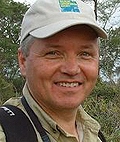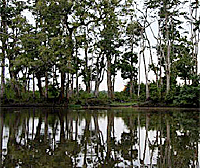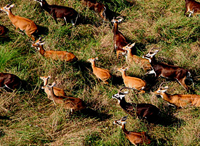Steven E. Sanderson, who stepped down as president and CEO of the Wildlife Conservation Society (WCS) this summer, has seen the good, the bad, and the ugly as head of one of the world’s largest conservation groups. He has watched as global CO2 emissions have soared; deforestation has intensified in Southeast Asia, Africa, and Latin America; and rising human populations have further imperiled biodiversity.

Julie Larsen Maher © WCS
Steven E. Sanderson
In an interview with Yale Environment 360 senior editor Fen Montaigne, Sanderson discusses the importance of not just creating protected areas but actively managing them; the urgent need for conservation groups to coordinate their efforts across sprawling regions facing intense development pressure, such as the western Amazon; the conservation success stories in countries such as South Sudan, Uganda, and Myanmar; and the importance of enlisting zoos — such as WCS’s Bronx Zoo — to help protect endangered species and reintroduce them into the wild.
Yale Environment 360: How has your thinking evolved about the most effective ways to work, particularly in developing countries, as you help local communities but also try to preserve wild lands and biodiversity?
Steven Sanderson: One of the most vivid realizations I’ve come to is that conservation is a matter of active management rather than simple protection. I think that sounds obvious, but it wasn’t. And so for a long, long time the world focused on the creation of protected areas rather than the active management of what was in those protected areas and also the interaction of protected areas with non-protected areas.
So the shift that’s been very powerful and in which WCS has been involved is that we have to protect not just these protected areas, although they’re invaluable, but we have to do more than that because we don’t want these to become islands of protection in a world of abuse. So we’ve begun to work more seriously in broader landscape scales than those million- to 10 million-acre protected area schemes that we have always specialized in.
e360: Can you give me some examples?
Sanderson: There’s a really good example in Bolivia. We’re involved with the Madidi National Park area, a really interesting area from the standpoint of human communities, biodiversity, and climate change, because it’s a vertically stratified area that goes from about 500 feet elevation in the Amazon to 16,000 to 18,000 feet in the Andes and the headwaters of the upper Amazon. And so that’s important from the climate change standpoint as animals and humans are going to be moving up and downslope according to ecological and resource opportunities.
We work in areas with indigenous communities and other landholders to protect their lands and to give them the kind of technical advice and conservation strategies that they can use to their benefit. We might be involved in a couple million hectares or so, but the catchment area is 25
What has failed is that we don’t work at large scales and we don’t work together well enough as organizations.”million hectares and crosses over from Bolivia into the lowlands of Peru and also into mid-latitude montane forest. And so we have to work across that entire span. We do a lot of research on the movement of animals. We engage communities in monitoring and evaluation of wildlife. But we also try with provincial governments, with local community governance, and with the national government to look at corridor protection. And that’s vividly the case in Tanzania and Uganda, in the Albertine Rift. It really is all about corridors. It’s also true in North America with our pronghorn [antelope] protection program. It’s working with stakeholders, private sector, state and local government, ranchers, etc., in trying to find a way that animals can move around both in the normal course of life and also as they adapt to climate change.
e360: If you were to advise your successor or other conservation leaders, what would you tell them has worked and what has failed on a global level?
Sanderson: What has failed is that we don’t work at large scales. And that means we don’t work together well enough as organizations. A great case is the western Amazon. The western Amazon is not going to be saved by our investing in a small community strategy. Somebody’s got to change the equation in the western Amazon, where 150 dams are proposed to be built and the area of greatest biodiversity and greatest ethnic diversity in the Peruvian, Ecuadorian, Columbian Amazon is really at high risk of being completely redone for infrastructure purposes. That’s got to change or we’re going to lose. Now that’s a physical, political, and temporal scale that is way beyond what we do.

WCS
The WCS helped Gabon set aside 10 percent of its land area in a system of national parks.
e360: You are running into the economic interests of powerful players in those countries who want those dams built, who want those roads put in. So explain to me how you can persuade those interests to take half a loaf of development instead of the whole loaf?
Sanderson: I could make an argument that this is in their economic interest because it’s stewardship of natural capital. But it’s in their short term economic interest to ignore all of that. And because we’re not economic interests ourselves, one of the things that’s failed is that we have not claimed an important enough part of the agenda. The alteration of massive areas of public lands for the sake of short-term economic gain or even long-term infrastructure development ought to be contested in the public domain. Another thing is that when we have come up against important economic stakeholders, we’ve quite often found them to be pretty responsible.
e360: You’re saying that scientific research needs to be used more effectively in these big debates about resource development, wild lands, etc.?
Sanderson: I think the role of science has been marginalized in all of this for a couple of reasons. One is that there’s an anti-intellectualism and an anti-scientific perspective that we’ve seen in the climate change debate that’s just been grossly irresponsible. So science has been devalued in our
“Science has been devalued in our society, and science has a lot to say about what we should be doing.”society, but also in the global discourse. And science has got a lot to say about what we should be doing.
For example we have been tracking elephant seals in southern South America for the last few years and we have marveled at the results. We’ve got an elephant seal that in the course of a year or so went 18,000 miles from the Atlantic to the Pacific, and so when we looked at that we said we’ve got to protect that animal’s course of life and that involves protection of the landscape and seascape.
You can’t just say, well, I’m going to protect where it breeds. You’ve got to protect where it feeds, and so that changes the agenda and that’s all based on scientific observation. So you’ve got to be out there, you have to elevate the scientific aspect of your work. So one thing that we haven’t done is to build the resource base for proper science. I would like to see my former colleagues in the university world become much more applied than they are and for universities and science to really throw our efforts into constructive solutions to long term problems.
e360: On the biodiversity front, which is really the heart of what WCS does in terms of working with wildlife, where do you see reasons for optimism?
Sanderson: Well, you know, it’s sort of the triumph of the human spirit, because if you go to places we work — places that have the least possible [financial] resources to make a difference in biodiversity — they’re committed to it. In South Sudan, the provisional government asked us if we would help them think through the issues of their surviving biodiversity. We had an old history with the region and we found these incredible ecological phenomena, an abundance of species that were thought to be gone — oryx and kob and giraffes and elephants and so forth.
e360: Millions of undiscovered migrating animals…

WCS / © P. Elkin & M. Fay
In South Sudan, aerial photos taken after years of civil war revealed that populations of white-eared kob were nearly as abundant as before the war.
e360: Why is the preservation of biodiversity in a place like South Sudan, which has so many other problems, a top priority? And what has the government asked you to do?
Sanderson: The southern portion of the country is extremely rich in land and water assets that are fundamental to the survival of the country. So the government is trying to figure out how to make it work for them. There is tremendous pressure to develop hydrocarbon reserves in the area. So the leadership, for reasons of long-term viability of the country and because the natural endowments of the country are so important to them, wanted to figure this out. We try to be out there where ecosystems are relatively intact and despite more than two decades of war, the stunning thing was that the wildlife were left relatively intact. The other thing is that they have important world resources — the Sudd is one of the largest wetlands in the world, an area the size of Austria. So it must be pretty evident to the people who are in charge of the country that this is a resource that they really have to manage.
e360: Do you think there is an appreciation on the part of the South Sudanese government that this could help develop their country if these areas are preserved for ecotourism?
Sanderson: There is no question that they’re looking at that. I mean if you look just to the south, Uganda is harvesting a tremendous foreign
“We will make a huge difference because of the zoo here and other captive breeding programs worldwide.”exchange benefit from peace and ecotourism. And, you know, this is a place that in the time of Idi Amin went through hell in the way that Cambodia did, in the way that South Sudan and other countries have gone through hell. Now Uganda has recovered and they are realizing hundreds of millions of dollars from the tourist economy. Uganda has lions, Murchison Falls, the Mountains of the Moon, gorillas, chimps, open spaces of real spectacular beauty — it just goes on and on.
e360: Let me ask you about REDD, reducing emissions from deforestation and forest degradation. What is the promise of REDD in the 21st century for climate change and biodiversity and what progress has been made?
Sanderson: Land cover transformation by humans might explain 20 to 25 percent of the total carbon [emissions] budget. It’s bigger than transportation, so it’s a big deal. So I think the REDD discussion is really important. It has unfortunately been more about the organization of financing the REDD mechanism than it has been about actual protection of these resources. It has also focused on the unbelievably specific terms of verification and monitoring. So the perfect has become the enemy of the good.
In my view there are many, many places where we could reduce emissions from deforestation and forest degradation and also apply it to non-forested environments — peatlands, for example. I think we’ll see in the next few months real deals being done that will prove the principle that there is a way to protect carbon and reduce forest loss. I believe in the concept. I think there are great assets to be brought to bear. This is the way to indemnify the Congo basin countries, the poorest countries that have not yet deforested their areas. It’s a way to protect the western Amazon, to monetize the value of protection.
e360: You think the emphasis on the financial mechanisms has been misplaced?
Sanderson: There are ways to buy up concessions for conservation, protect peatlands and so forth that are not based on having to have a seamless multilateral mechanism. So I think the compliance regime that the multilateral process is focused on has really been at the expense to some degree of helping small countries find appropriate strategies for protecting carbon and reducing the net emissions in the atmosphere. If you concentrate on the big [developing] countries — China, India, Brazil, Indonesia, etc. — those folks are not going to come to the table with binding emisisons agreements that lock them in. Why not turn to the countries that really would like to do something significant — the Cambodias, the Madagascars, the Chiles of the world — where we can make some real gains and then work from there, from the ground up?
e360: Many people may know about the Bronx Zoo, but they might not have heard of the Wildlife Conservation Society. Can you say how zoos like the Bronx Zoo can work hand-in-hand with field conservation efforts?
MORE FROM YALE e360
Africa’s Ambitious Experiment To Preserve Threatened Wildlife

e360: And you have turtles here now that you’re taking care of?
Sanderson: Yes, absolutely. And these are the ones that are at greatest risk. It’s something I think that the governments of South Asia and Southeast Asia will embrace and where we will make a huge difference because of the zoo here and other captive breeding programs around the world.